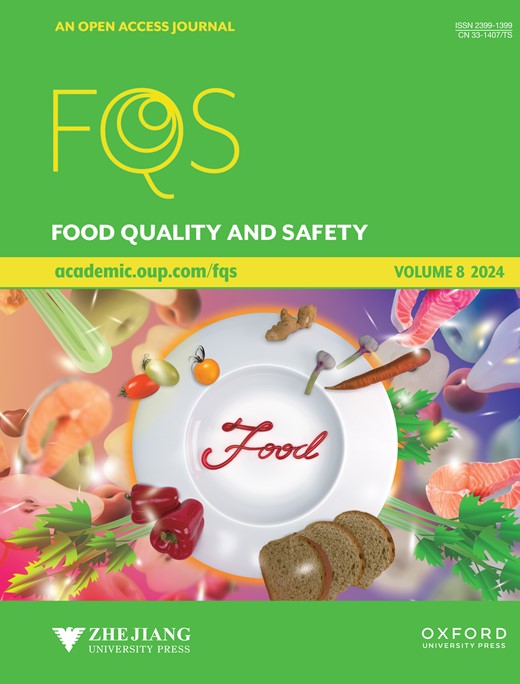基于竞争自适应重加权采样和支持向量回归的拉曼光谱快速植物油脂肪酸检测
IF 4.4
3区 农林科学
Q2 FOOD SCIENCE & TECHNOLOGY
引用次数: 0
摘要
脂肪酸的组成和含量是植物油质量的重要指标。为了克服传统检测方法的缺点,研究了拉曼光谱法快速测定油脂中脂肪酸的组成。在不同的储存时间,收集油箱不同深度的菜籽油和大豆油,并使用八次多项式函数拟合拉曼光谱。然后,比较了多元散射校正、标准正态变量变换(SNV)和Savitzky Golay卷积平滑方法。多项式拟合与SNV相结合是最佳的预处理方法。特征波长是通过竞争自适应重新加权采样来选择的。对于单不饱和脂肪酸(MUFA)、多不饱和脂肪酸酯(PUFA)和饱和脂肪酸,提取了菜籽油的44、75和92个特征波长,以及大豆油的60、114和60个特征波长。采用支持向量回归方法建立预测模型。MUFA、PUFA和SFAs对菜籽油的预测结果的R2值分别为0.9670、0.9568和0.9553,RMSE值分别为0.0273、0.0326和0.0340。大豆油脂肪酸预测结果的R2值分别为0.9414、0.9562和0.9422,RMSE值分别为0.0460、0.0378和0.0548。获得了良好的相关系数和较小的RMSE值,表明结果是高度准确和可靠的。拉曼光谱法基于竞争自适应重加权采样和支持向量回归,可以快速准确地分析植物油中的脂肪酸组成。本文章由计算机程序翻译,如有差异,请以英文原文为准。
Rapid Fatty Acids Detection of Vegetable Oils by Raman Spectroscopy Based on Competitive Adaptive Reweighted Sampling Coupled with Support Vector Regression
The composition and content of fatty acids are critical indicators of vegetable oils quality. To overcome the drawbacks of traditional detection methods, Raman spectroscopy was investigated for the fast determination of fatty acids composition in oil.
Rapeseed and soybean oil at different depths of the oil tank at different storage times were collected, and an eighth-degree polynomial function was used to fit the Raman spectrum. Then, the multivariate scattering correction, standard normal variable transformation (SNV), and Savitzky-Golay convolution smoothing methods were compared.
Polynomial fitting combined with SNV was found to be the optimal pretreatment method. Characteristic wavelengths were selected by competitive adaptive reweighted sampling. For monounsaturated fatty acids (MUFAs), polyunsaturated fatty acids (PUFAs), and saturated fatty acids (SFAs), 44, 75, and 92 characteristic wavelengths of rapeseed oil, and 60, 114, and 60 characteristic wavelengths of soybean oil were extracted. Support vector regression was used to establish the prediction model. The R 2 values of the prediction results of MUFAs, PUFAs, and SFAs for rapeseed oil were 0.9670, 0.9568, and 0.9553, and the RMSE values were 0.0273, 0.0326, and 0.0340, respectively. The R 2 values of the prediction results of fatty acids for soybean oil were respectively 0.9414, 0.9562, and 0.9422, and RMSE values were 0.0460, 0.0378, and 0.0548, respectively. A good correlation coefficient and small RMSE value were obtained, indicating the results to be highly accurate and reliable.
Raman spectroscopy, based on competitive adaptive reweighted sampling coupled with support vector regression, can rapidly and accurately analyze the fatty acid composition of vegetable oil.
求助全文
通过发布文献求助,成功后即可免费获取论文全文。
去求助
来源期刊

Food Quality and Safety
FOOD SCIENCE & TECHNOLOGY-
CiteScore
7.20
自引率
1.80%
发文量
31
审稿时长
5 weeks
期刊介绍:
Food quality and safety are the main targets of investigation in food production. Therefore, reliable paths to detect, identify, quantify, characterize and monitor quality and safety issues occurring in food are of great interest.
Food Quality and Safety is an open access, international, peer-reviewed journal providing a platform to highlight emerging and innovative science and technology in the agro-food field, publishing up-to-date research in the areas of food quality and safety, food nutrition and human health. It promotes food and health equity which will consequently promote public health and combat diseases.
The journal is an effective channel of communication between food scientists, nutritionists, public health professionals, food producers, food marketers, policy makers, governmental and non-governmental agencies, and others concerned with the food safety, nutrition and public health dimensions.
The journal accepts original research articles, review papers, technical reports, case studies, conference reports, and book reviews articles.
 求助内容:
求助内容: 应助结果提醒方式:
应助结果提醒方式:


